Computations for Pyne et al. 339 bp sequence
In this page we show the minimizations results for each initial guess. In the table we show the energy, the norm of the gradient of the energy function with the obtained configuration, some data of the eigenvalues and the Hessian condition number. In particular what we can observe in this case is that all the solutions have only positive eigenvalues.
Solution for initial guess A:
We run fminunc Matlab function with Quasi-Newton algorithm and tolerance for the first order optimality of 1.0e −6. The absolute difference of the two configurations obtained with the two different initial guesses is of the order of 10e −03. We then run the fminunc Matlab function again with Trust Region algorithm and first order optimality of 1.0e −6, but having as starting point the solutions obtained with the first Quasi-Newton run. Doing that we obtained an absolute difference of the two configurations with the two different initial guesses of the order of 10e −04.
| bBDNA | bBDNA with gd-intras | |
| Energy | 15.5709 | 15.5434 |
| Norm of the gradient | 0.0232 | 0.0113 |
| Min Hess eigenvalue | 2.1046e-07 | 1.2818e-07 |
| Max Hess eigenvalue | 6.7081e+04 | 6.7083e+04 |
| Median Hess eigenvalue | 11.6687 | 11.6688 |
| Number of negative eigenvalues | 0 | 0 |
| Hessian condition number | 8.2116e+11 | 1.3584e+12 |
| Number of links | 33 | 33 |
3D plot of the configuration obtained with the bBDNA initial guess.
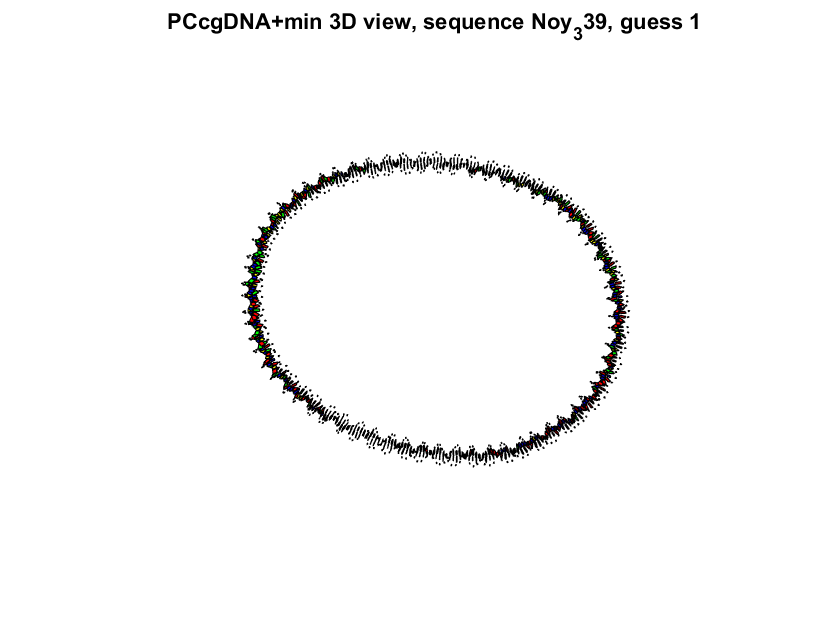
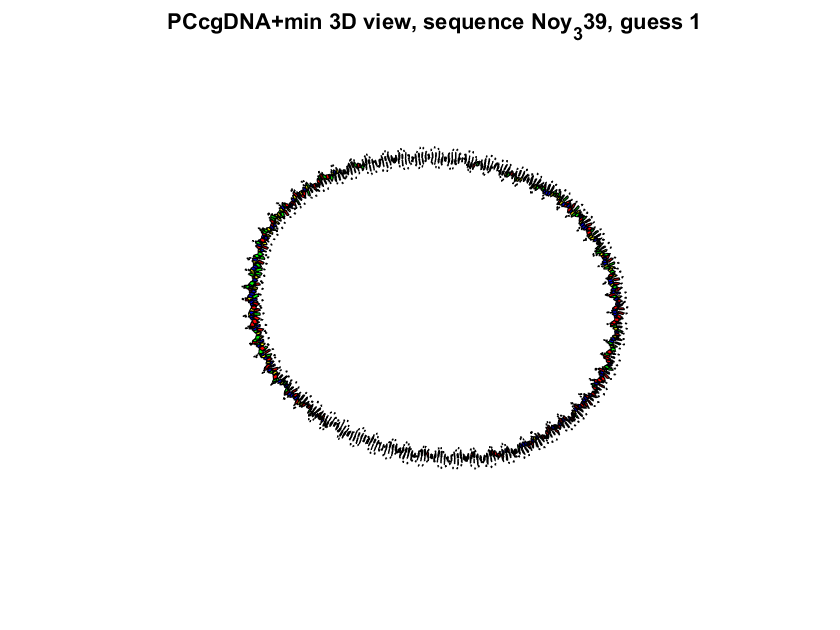
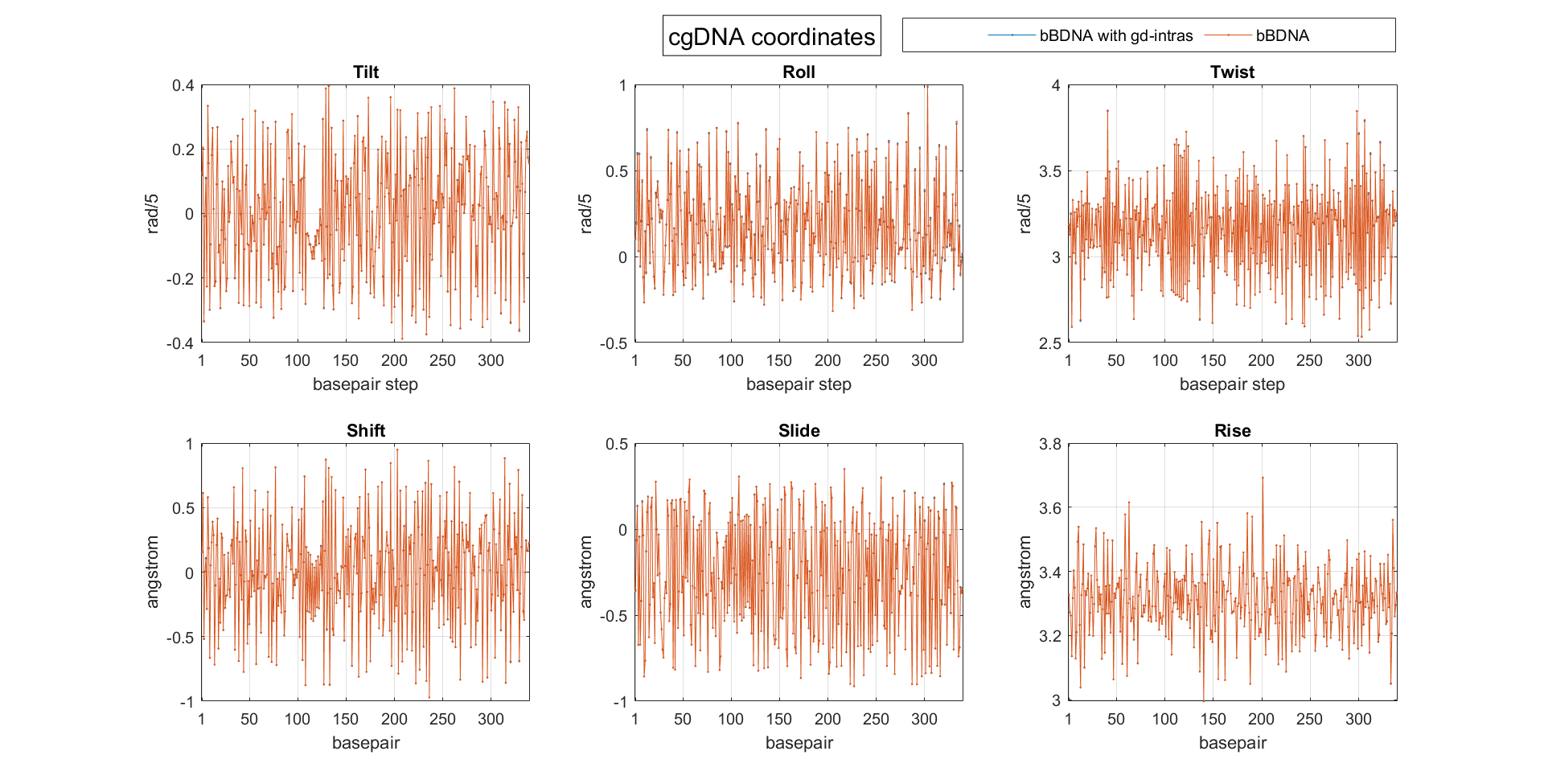
MATLAB figures saved variables: P339-3D-GUESS1tr-bBDNA.fig
P339-3D-GUESS1tr-bBDNAgd.fig
P339-2D-GUESS4tr.fig
Solution for initial guess B:
We used fminunc Matlab function with Trust Region algorithm and tolerance for the first order optimality of 1.0e − 6. The absolute difference of the two configurations obtained with the two different initial guesses is of the order of 10e −02.
| bBDNA | bBDNA with gd-intras | |
| Energy | 20.4514 | 20.4059 |
| Norm of the gradient | 0.0876 | 0.0539 |
| Min Hess eigenvalue | 2.8500e-07 | 2.8502e-07 |
| Max Hess eigenvalue | 6.8838e+04 | 6.8732e+04 |
| Median Hess eigenvalue | 11.6586 | 11.6585 |
| Number of negative eigenvalues | 0 | 0 |
| Hessian condition number | 6.4429e+11 | 1.0332e+12 |
| Number of links | 32 | 32 |
3D plot of the configuration obtained with the bBDNA initial guess.
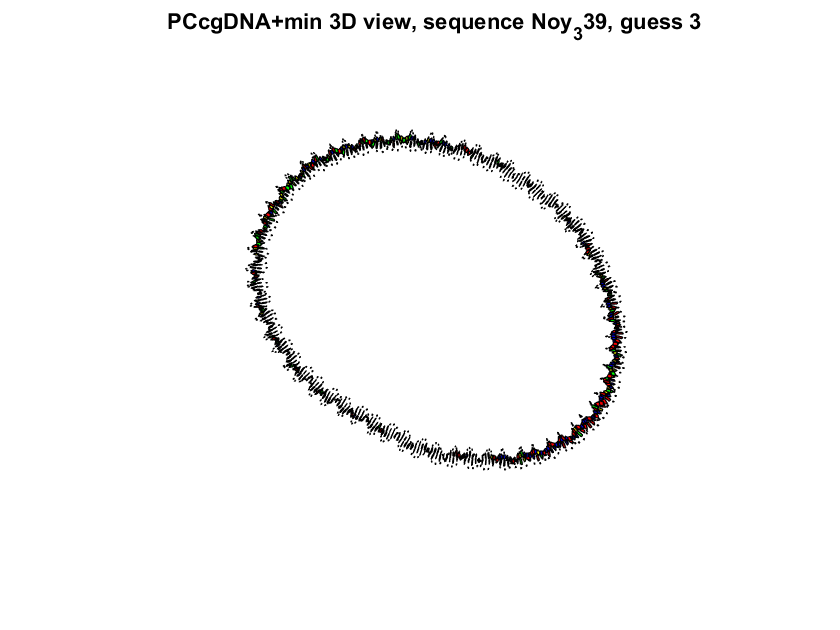
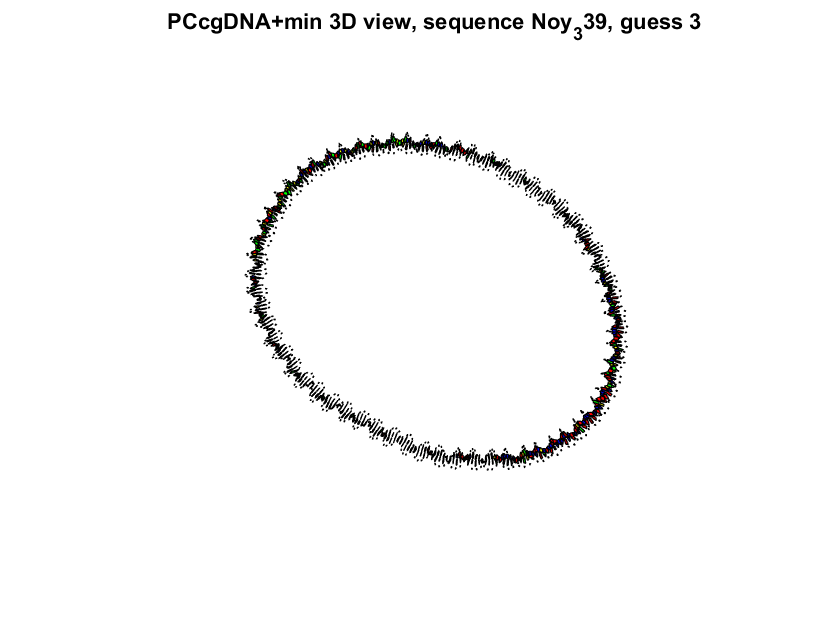
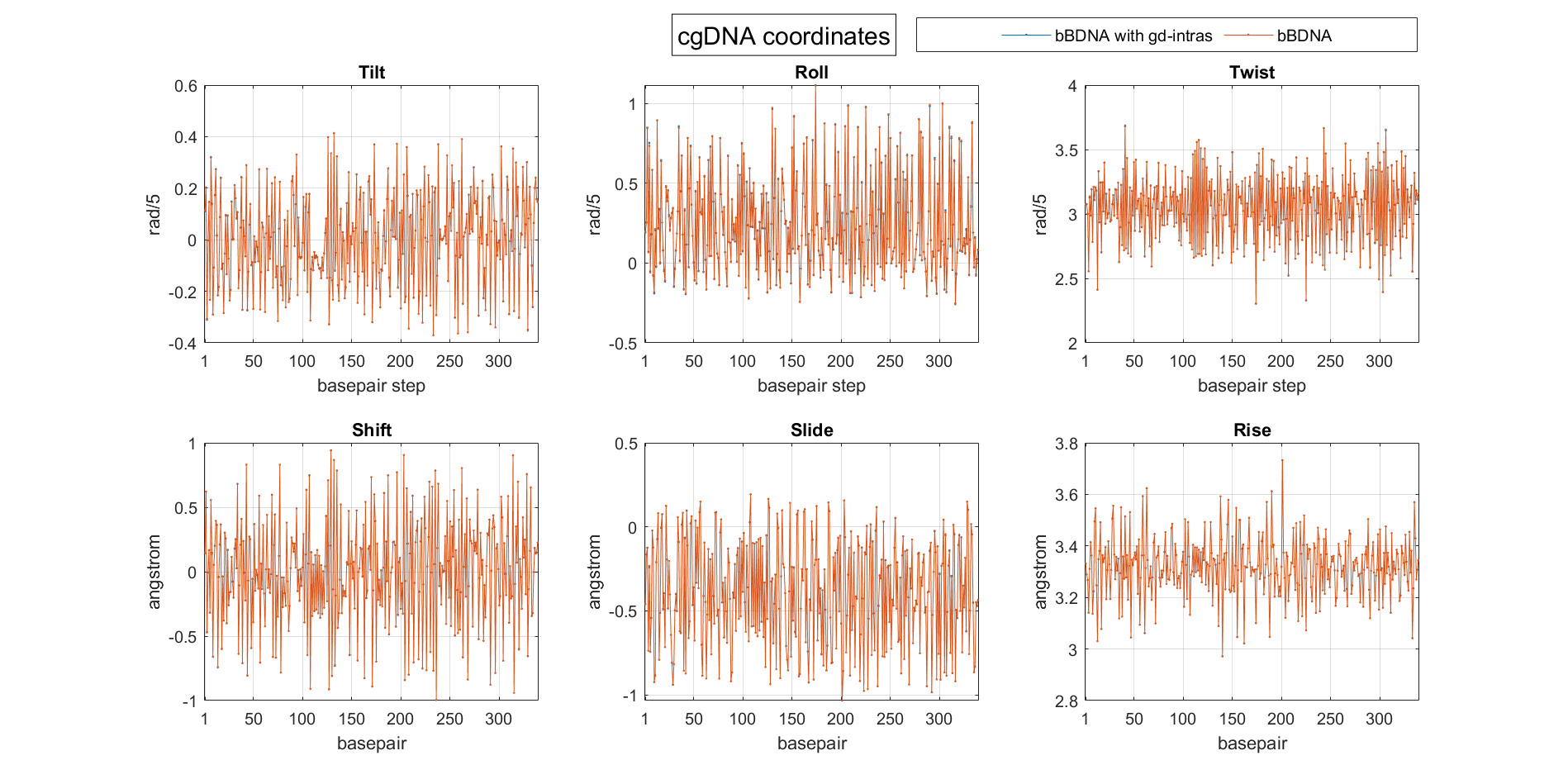
MATLAB figures and saved variables:
P339-3D-GUESS3-bBDNA.fig
P339-3D-GUESS3-bBDNAgd.fig
P339-2D-GUESS3.fig
Solution for initial guess C:
We used fminunc Matlab function with Trust Region algorithm and tolerance for the first order optimality of 1.0e − 6. The absolute difference of the two configurations obtained with the two different initial guesses is of the order of 10e −02.
| bBDNA | bBDNA with gd-intras | |
| Energy | 21.2955 | 21.1221 |
| Norm of the gradient | 0.0767 | 0.0557 |
| Min Hess eigenvalue | 6.4206e-08 | 1.1106e-07 |
| Max Hess eigenvalue | 6.6768e+04 | 6.6768e+04 |
| Median Hess eigenvalue | 11.6666 | 11.6665 |
| Number of negative eigenvalues | 0 | 0 |
| Hessian condition number | 2.7352e+12 | 1.5177e+12 |
| Number of links | 32 | 32 |
3D plot of the configuration obtained with the bBDNA initial guess.
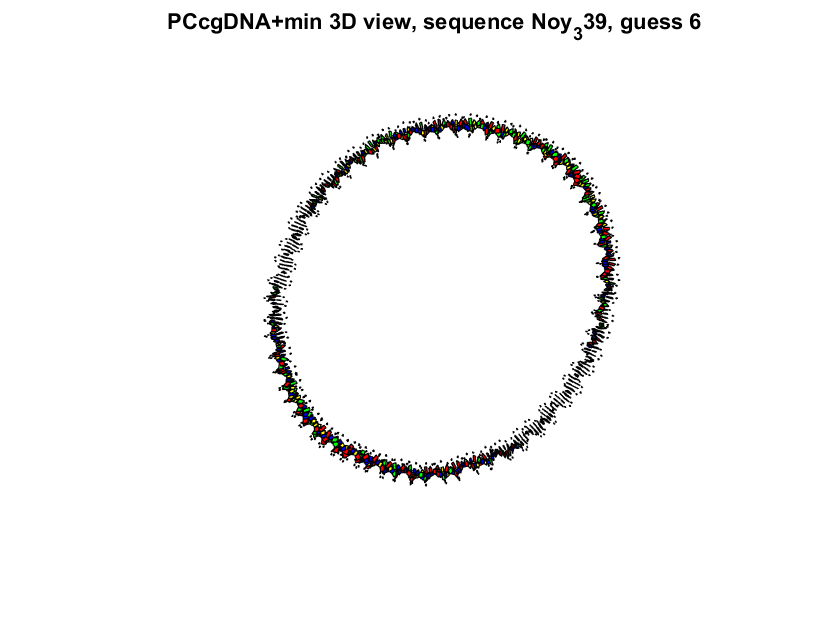
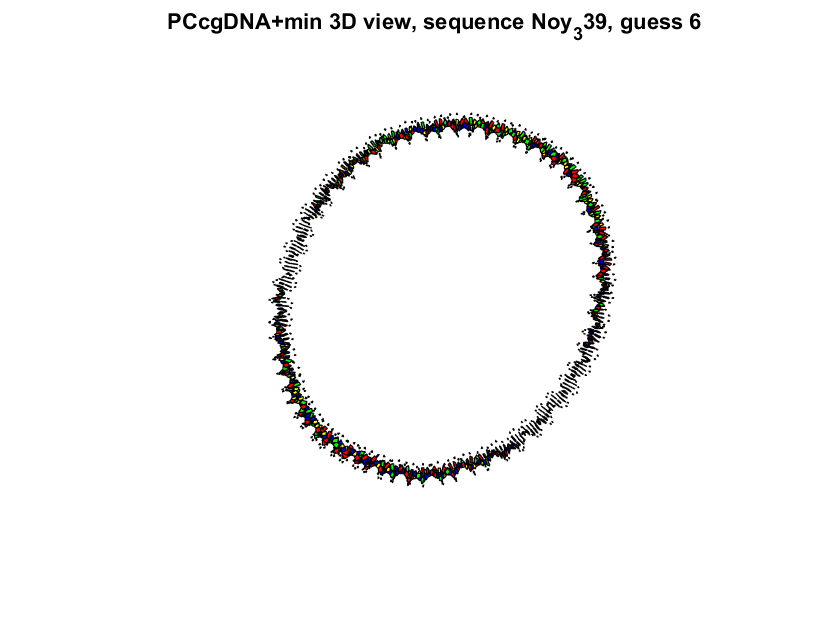
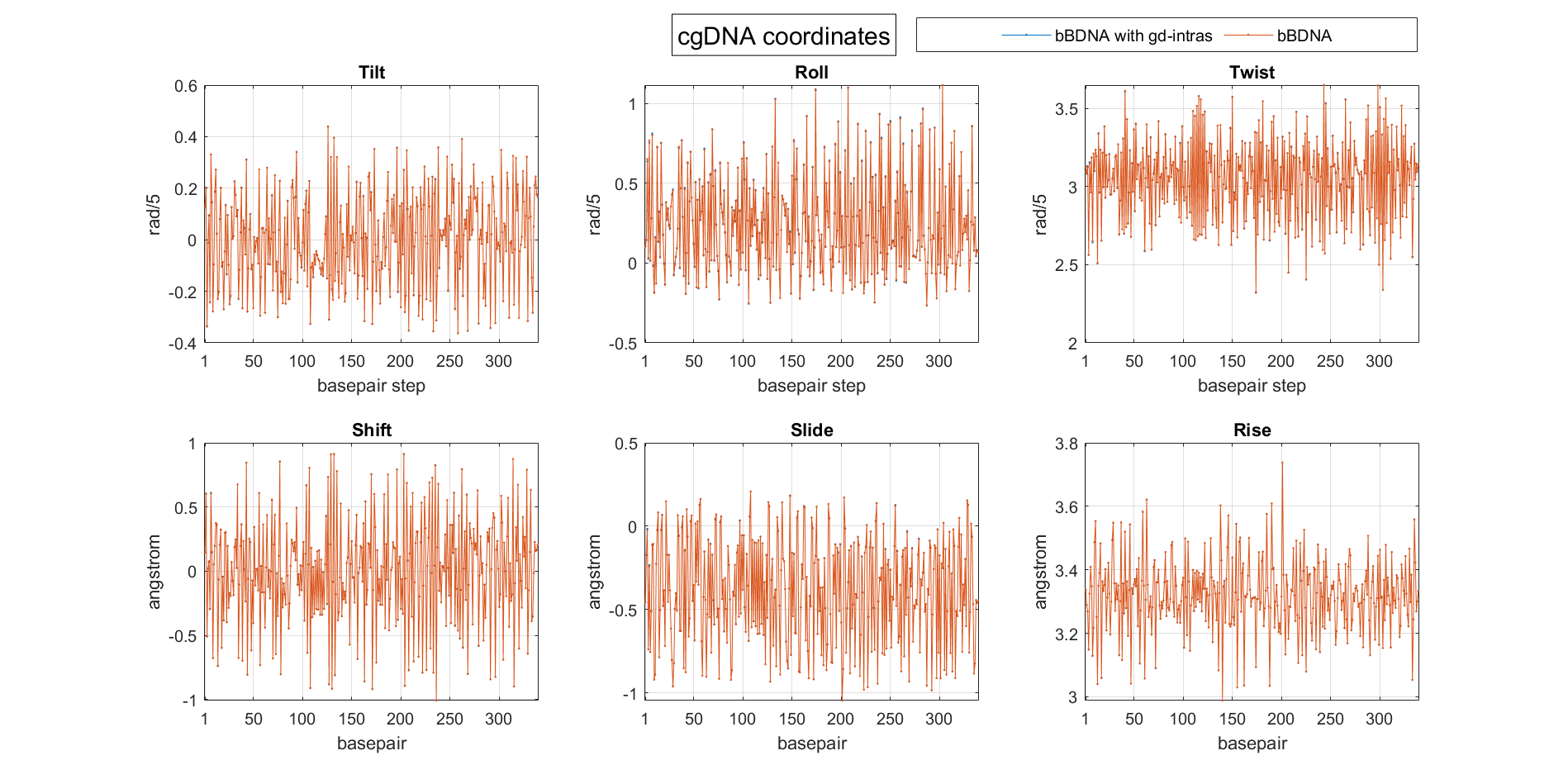
MATLAB figures and saved variables:
P339-3D-GUESS6-bBDNA.fig
P339-3D-GUESS6-bBDNAgd.fig
P339-2D-GUESS6.fig
Solution for initial guess D:
We run fminunc Matlab function with Quasi-Newton algorithm and tolerance for the first order optimality of 1.0e −6. The absolute difference of the two configurations obtained with the two different initial guesses is of the order of 10e −03.
| bBDNA | bBDNA with gd-intras | |
| Energy | 604.9322 | 604.1401 |
| Norm of the gradient | 35.8213 | 37.0695 |
| Min Hess eigenvalue | -7.8645e-04 | -8.2728e-04 |
| Max Hess eigenvalue | 6.4288e+04 | 6.4294e+04 |
| Median Hess eigenvalue | 11.6202 | 11.6187 |
| Number of negative eigenvalues | +5 | +5 |
| Hessian condition number | 2.3881e+8 | 2.3640e+8 |
| Number of links | 28 | 28 |
3D plot of the configuration obtained in Beaud's thesis versus the one obtained with the bBDNA initial guess and Quasi-Newton method.
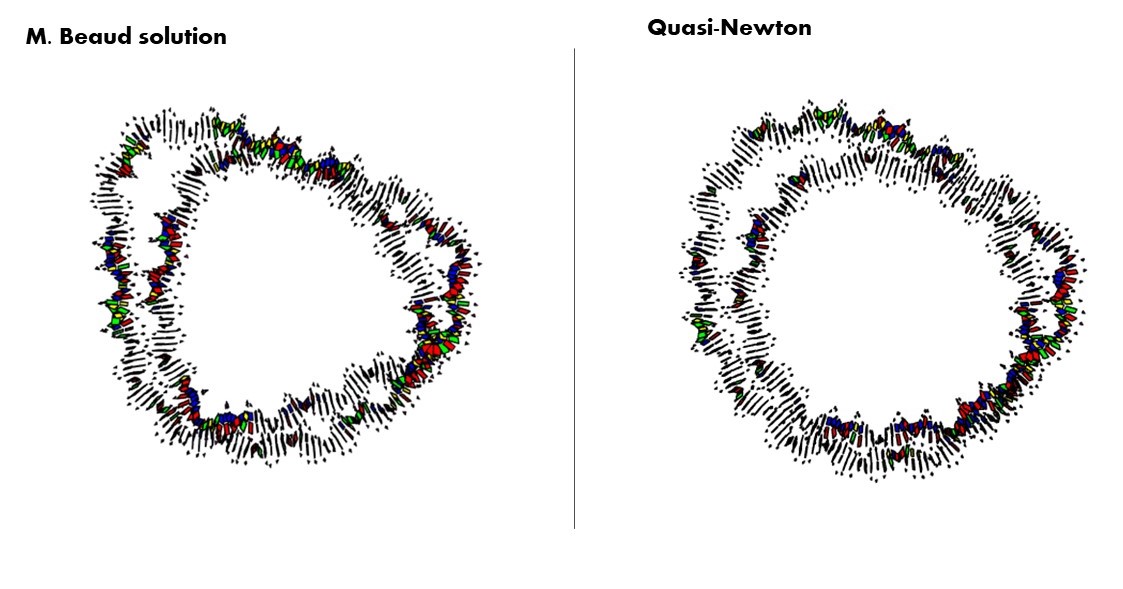
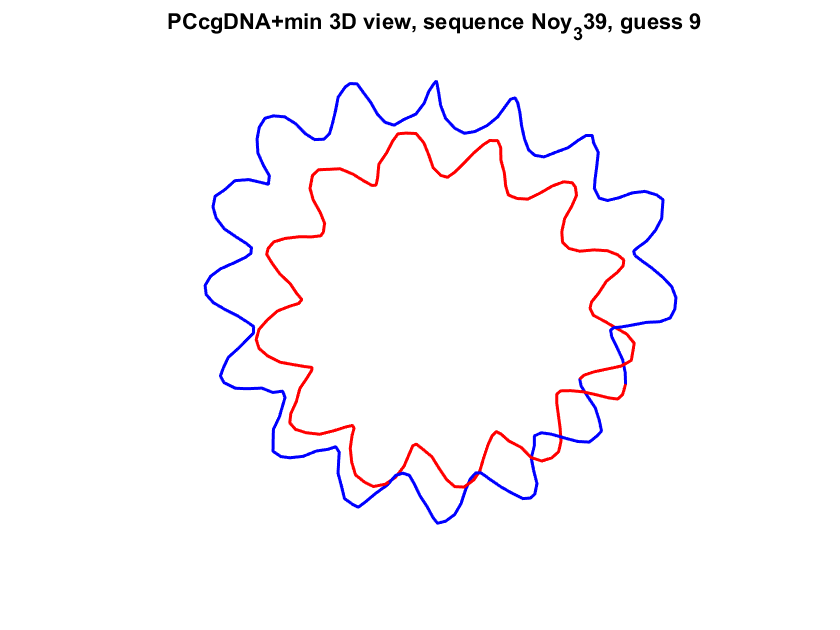
We then run Trust Region method using as initial point the ”optimum” found with Quasi-Newton method and a tolerance for the first order optimality of 1.0e −6. In particular we obtain a solution similar to the one obatained with initial guess 1. Furthermore, the absolute difference of the two solutions becomes of the order of 10e −04.
| bBDNA | bBDNA with gd-intras | |
| Energy | 15.6406 | 15.6078 |
| Norm of the gradient | 0.2485 | 0.0364 |
| Min Hess eigenvalue | 2.9066e-07 | 1.5568-07 |
| Max Hess eigenvalue | 6.7428e+04 | 6.7428e+04 |
| Median Hess eigenvalue | 11.6693 | 11.6692 |
| Number of negative eigenvalues | 0 | 0 |
| Hessian condition number | 7.9021e+11 | 1.0208e+12 |
| Number of links | 33 | 33 |
3D plot of the configuration obtained with the bBDNA initial guess.
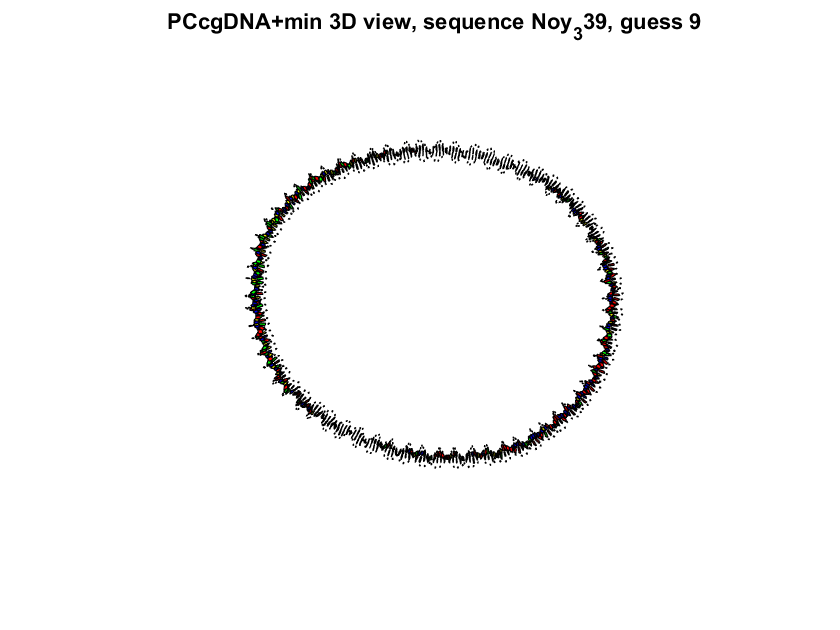
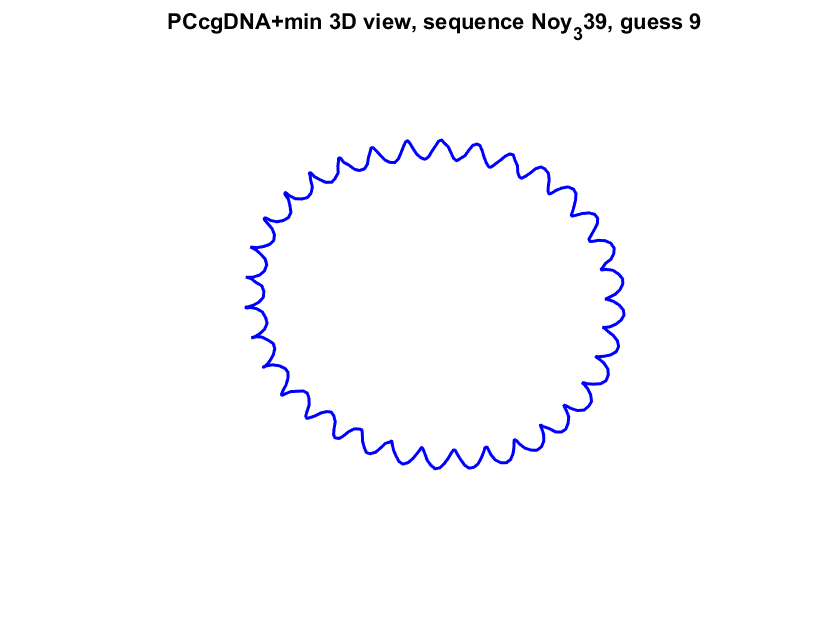
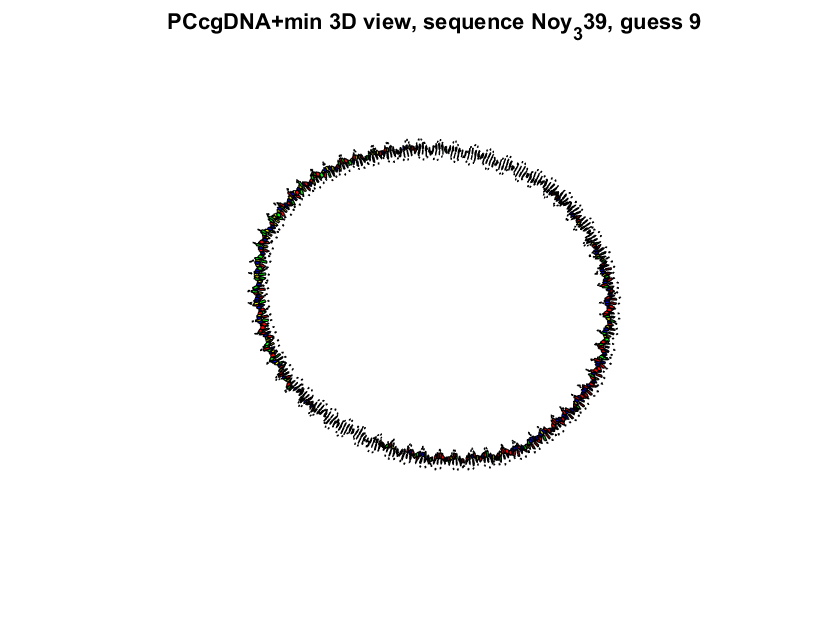

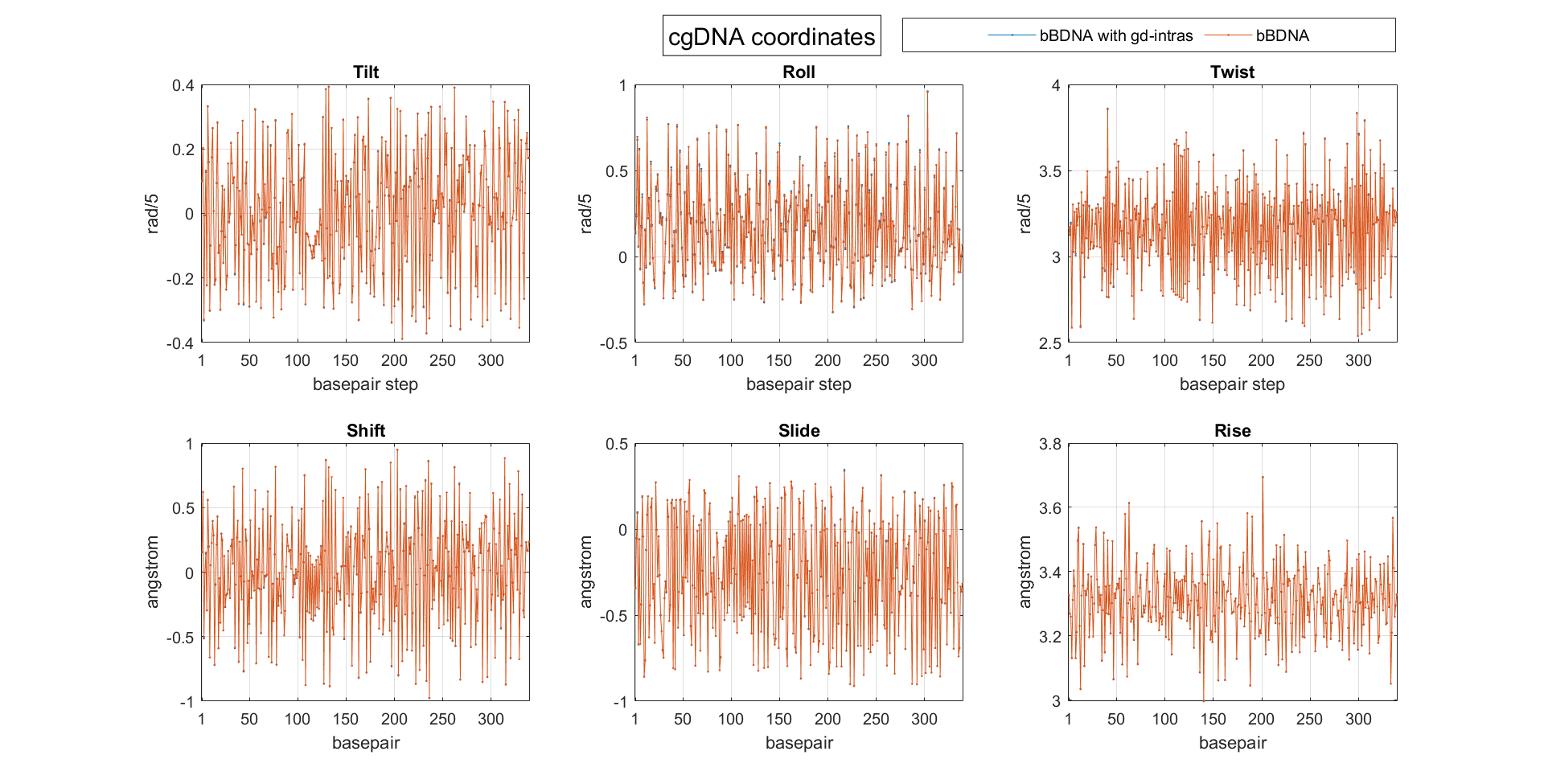
MATLAB figures and saved variables:
P339-3D-GUESS9-bBDNA.fig
P339-3D-GUESS9-bBDNAgd.fig
P339-2D-GUESS9.fig

